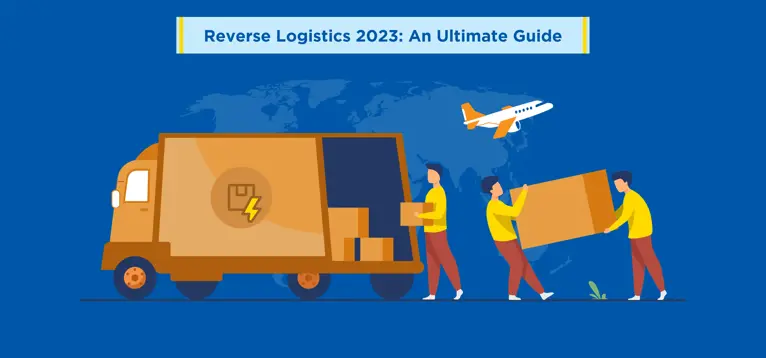Whether returns journeys present opportunities to strengthen a business’s relationships with customers or disappoint them hinges pretty much on the reverse logistics process it has adopted.
And despite the complex supply chain challenges of product returns owing to the explosion in international logistics and trade, reverse supply chains are now necessary. It is no surprise that the reverse logistics market, which accounted for $635.6 billion in 2020, will garner $958 billion by 2028.
So, companies are obliged to set up efficient reverse supply chains even if there is the cost of return processing and the risk that returned items might not be easily sold. They must leverage this opportunity to encourage exchange or repurchase, thereby recouping some of the original order value, offering a convenient customer service, reducing environmental impact, and fostering stronger customer loyalty.
In this article, you’ll learn everything you need about reverse logistics — its types, components, underlying process, benefits, and challenges. Most importantly, you’ll know how to improve reverse logistics so that it truly moves the needle for your business’s profitability.
What is Meant by Reverse Logistics?
Reverse logistics is the supply chain process for product returns from end users to the retailer or manufacturer. It involves eCommerce and retail returns, reshipping, along with repair and recycling.
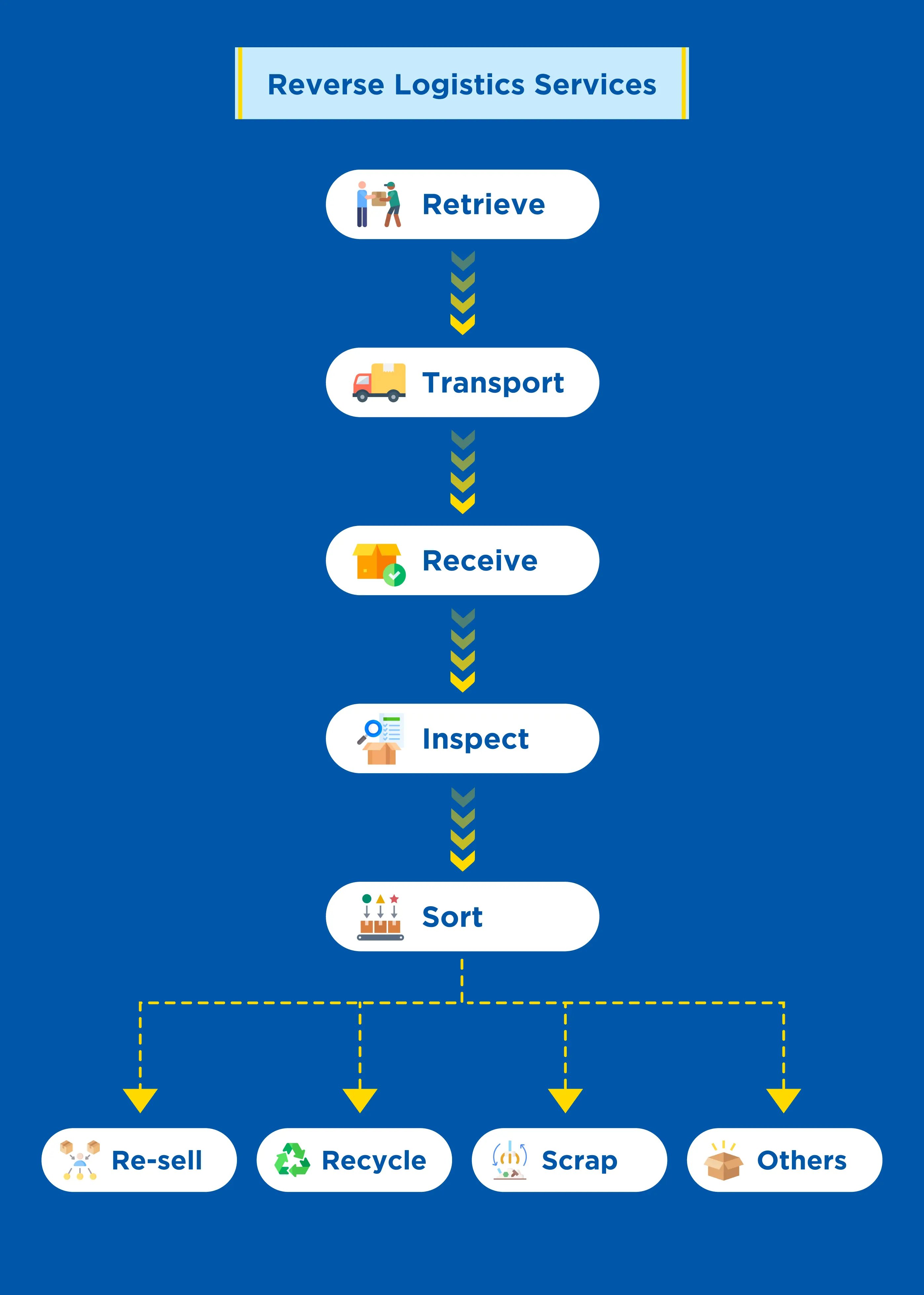
The items travelling backward through the supply chain typically are the products that need:
- Replacement
- Recycling
- Raw material reclamation
- Refurbishment
- Reselling, or
- Disposal
For instance, if the product is defective, the manufacturer would arrange reverse shipping. So the product can be tested and further action can be taken. Sometimes, the product is shipped back to the seller early on from the warehouse itself.
While the global retail and eCommerce upsurge is the key driver in high-volume eCommerce returns, the reverse logistics examples are not confined just to that.
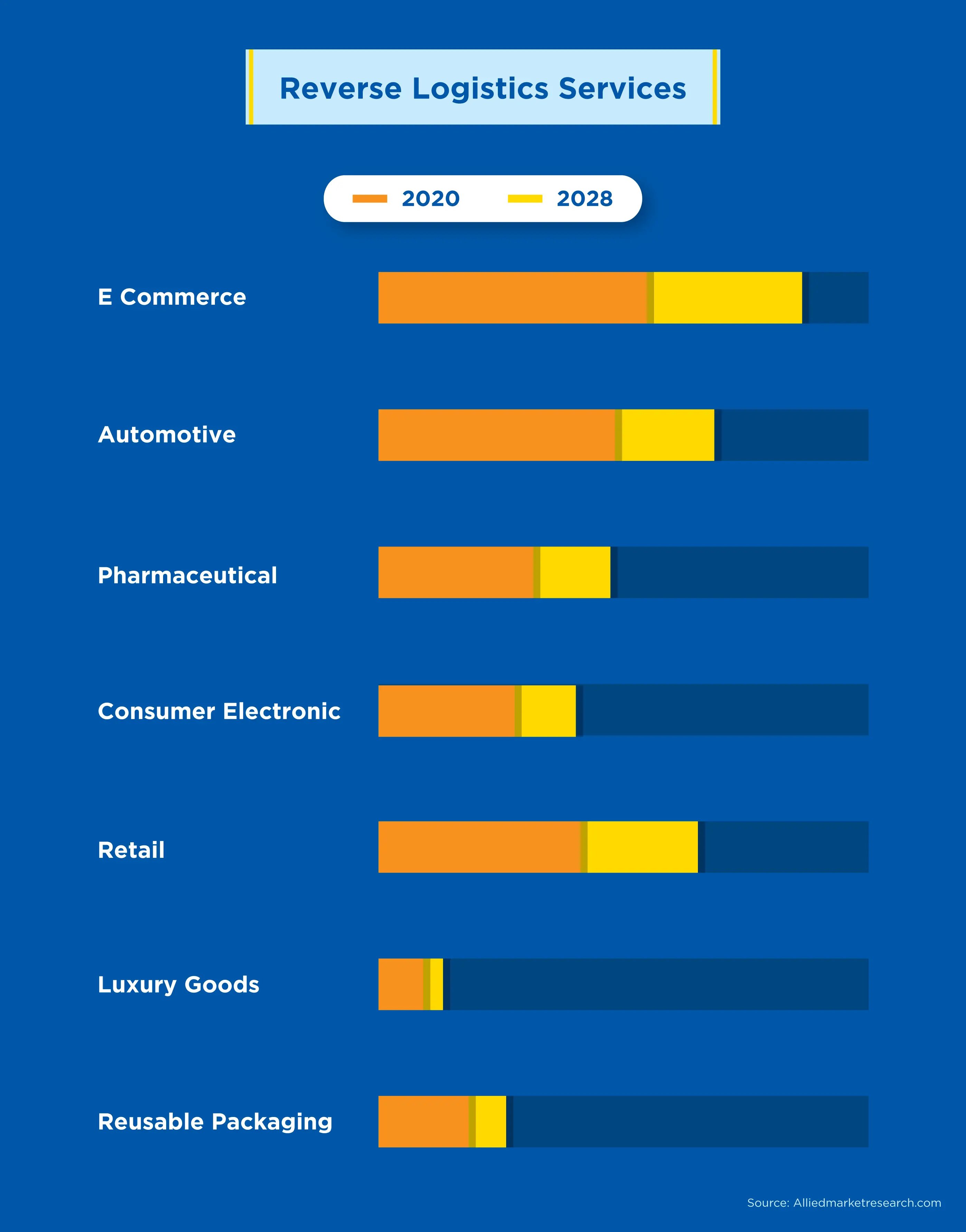
It could also be used in case of unsuccessful B2C or B2B deliveries. The management and sale of surplus inventory, raw materials, returns of leased equipment, and other hardware also make up use cases of reverse logistics.
And then let’s not forget the reverse logistics examples for automotive parts. Such as the classic one when the automotive giants BMW and Ferrari had to recall their vehicles due to faulty airbags.
How vital reverse logistics is for automotive parts is also exemplified by MG Motor India. In May 2021, it joined forces with Attero to employ its reverse logistics and recycling solutions to reduce e-waste and ensure passenger safety.
What Is the Difference between Forward and Reverse Logistics?
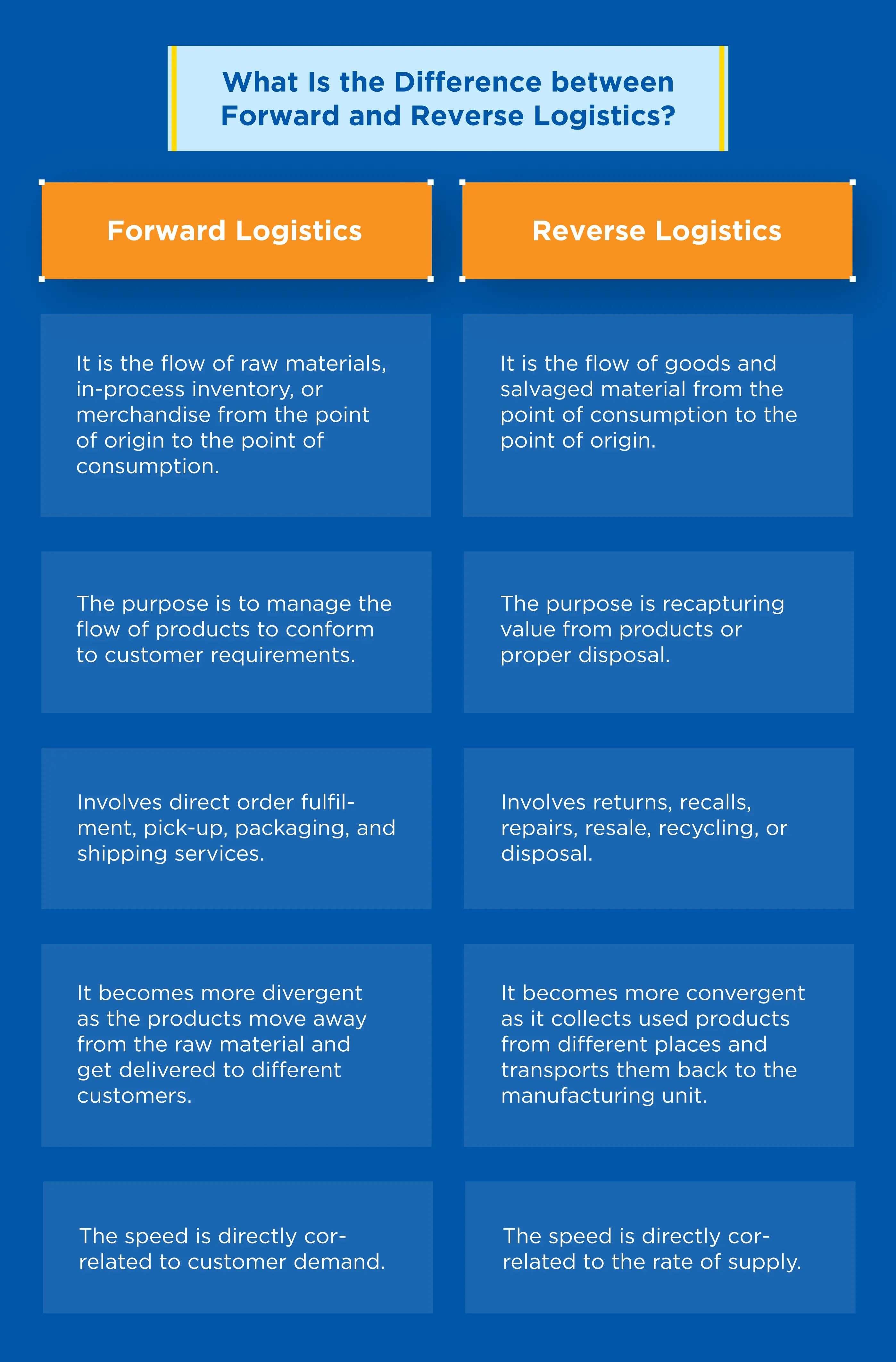
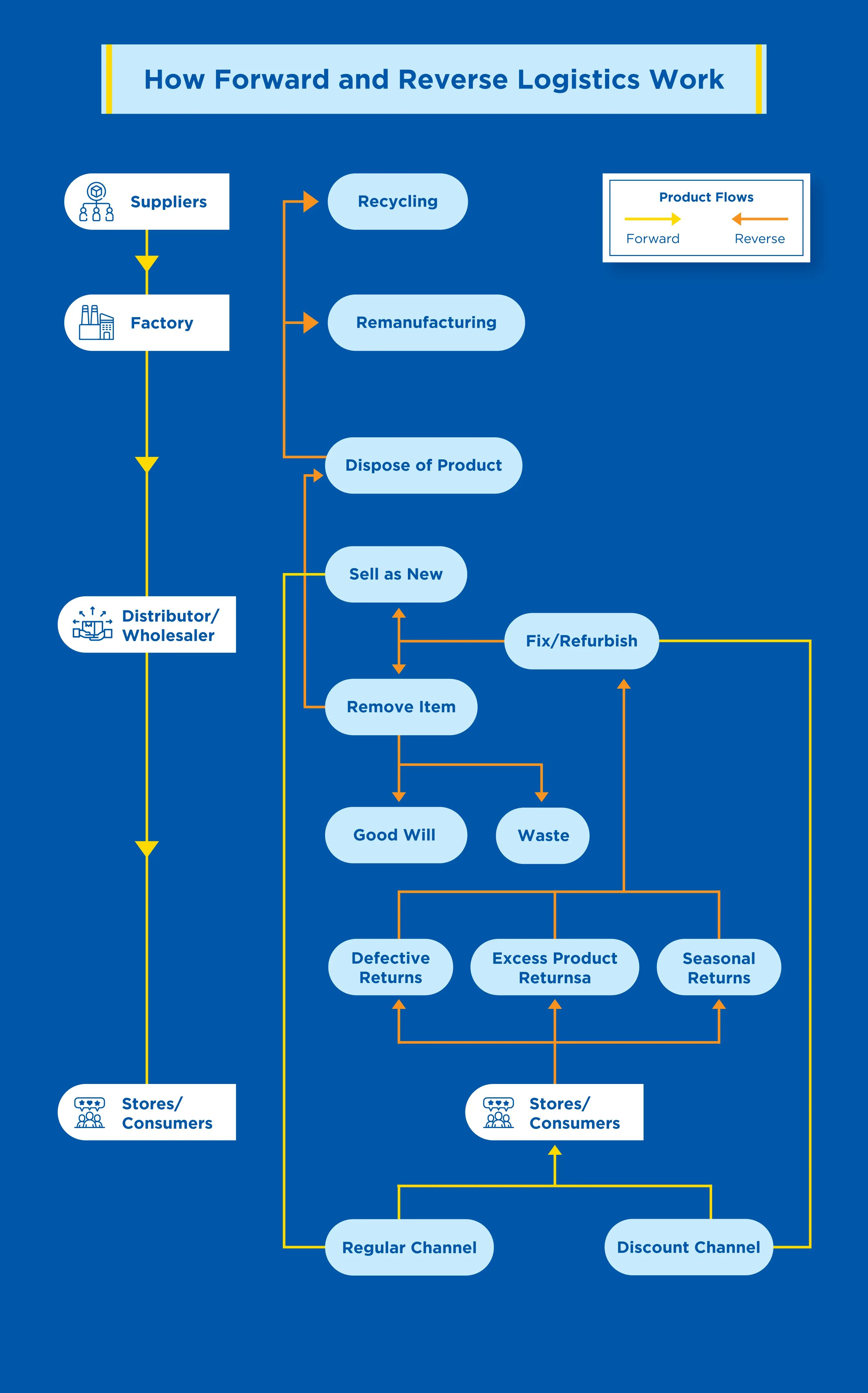
How Does Reverse Logistics Work?
The process of managing returns of goods can come in several stripes depending on the type of industry it operates in.
For instance:
- Ecommerce Reverse Logistics: It’s quite common for online shoppers to buy multiple products with the intent to return a few or all. The seller then provides return authorizations and captures details.
Once the item returns to the appropriate warehouse or distribution centre, the buyer receives the refund or store credit. And the seller reintroduces the items to the inventory or sends them to the relevant disposition channel.
- Manufacturing Reverse Logistics: The manufacturing firm ships back the defective or end-of-life product. After testing, the product is dismantled, repaired, recycled, or disposed of. The recovered parts are used to produce new items at a lower cost, with a smaller environmental footprint.
- Food and Beverage Industry Reverse Logistics: Although in its formative stage, reverse logistics has a pivotal role to play in the closed economy of food manufacturing. Here, manufacturers recover and process waste. So that to reuse it for different purposes to offset food waste and environmental impact.
Breweries streamline their reverse supply chain and retrieve the empty keg canisters. These are cleaned and refilled for further distribution.
Any which way, the basic breakdown of the reverse logistics process is as follows and applies more or less to all types of businesses.
The five stages of an effective reverse logistics process:
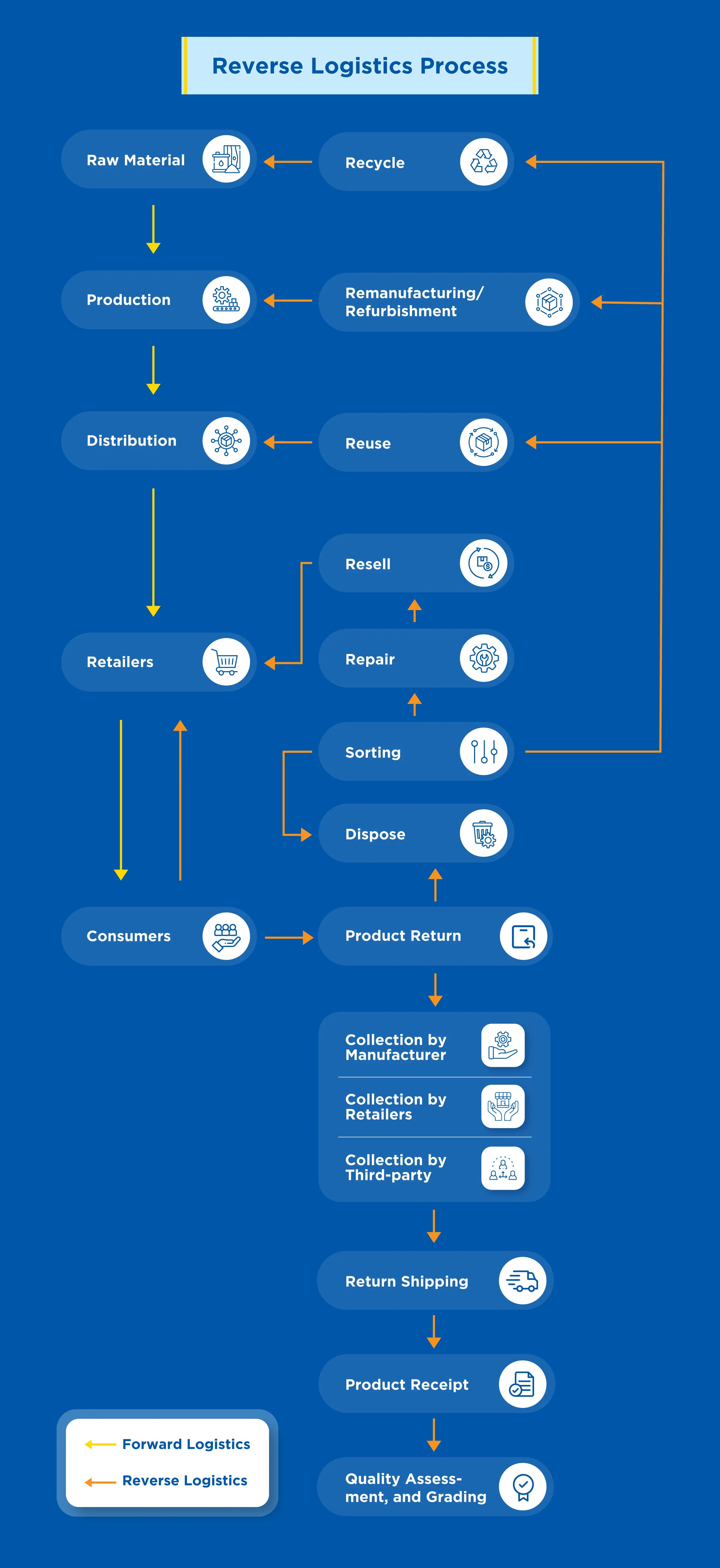
Labels: New label (Old label)
- Raw Material
- Production
- Distribution
- Retailers
- Consumers
- Product return
- Collection by Manufacturer, Collection by Retailers, Collection by Third-party
- Return shipping
- Product receipt
- Quality assessment, and Grading
- Sorting
- Repair
- Resell
- Dispose
- Reuse
- Remanufacturing/ Refurbishment
- Recycle
1. Initiate the Return Process
On receiving a customer's return request, the company sets the process in motion as per its standard operating procedure. It maps out the stepwise execution of the process the returned item will go through. This step involves return authorization, shipment scheduling, refund approval, and replacement.
2. Ship the Returned Product
The shipment is picked up from the buyer and brought to the reverse logistics warehouse. Here, handing the return shipping responsibilities to a shipping expert like us can be a smart move. It not only takes a heavy burden off your shoulders but also offers you an opportunity to enhance your customer experience.
Apart from that, acquiring the product on time is often the key to a profitable chain for a business. If the quantity, quality, and time are not well-coordinated, businesses may find themselves neck-deep with returned products with such variable return items that efficient remanufacturing becomes challenging.
Besides the shipping and storing costs, companies should also consider how quickly the value of the returned product will decline.
3. Categorise the Return
The product then moves to the centralised processing centre. At this spot, it undergoes thorough checks to assess its condition or any damage to the product. It is also the time to sort them in their return category — refurbishment, recycling, or resale.
In a robust reverse logistics process, product segregation, grading, and assessment should be rather efficient. It makes it easy for the business to identify the defect and categorise the return in the right disposition bucket even before it arrives. By doing so, businesses can expedite the return process, eliminate many logistics costs, and get the remanufactured product to the market faster.
4. Move to the Designated Area
Getting the most value from the return is also about keeping the returned product in motion. It ensures that the items only sit in warehouses for a short period and do not pile into waste. That’s because the extra storage space and labour required to store these items inevitably hold the costs. Plus, with time, the product's value and marketability depreciate.
Hence, the takeaway is to move items to the relevant department at the earliest possible time. Which is where they undergo appropriate processing and complete the remainder of their supply chain journey.
5. Repair
It is the most valuable step of the reverse logistics process because of the cost it saves in the long run. Companies can recapture value from the returned items if they can recondition the product or parts for reuse or remanufacturing.
The repairable items are dispatched to the repair department to be reinstated to the inventory. Even if the product is found irreparable, specific components can still be sellable to the manufacturers.
6. Recycle
Oftentimes, either of the above options is non-viable, leaving the organisation with the only choice — disposal. Nonetheless, businesses must do it with due diligence keeping environmental sustainability into account. Any part that can be recycled should be obtained by dismantling the product in full or in part.
With all the commitments to meet, companies understand the importance of efficiency. Still, they also know how challenging it is to gain efficiency for these inevitable reverse travel processes. This is where partnering with a specialist reverse logistics provider makes a difference.
What Are the Types of Reverse Logistics?
The following are the main types of components of reverse logistics:
Returns Management
With retail returns soaring to $761 Billion in 2021, returns management is gaining traction as a foundational component of healthy retail reverse logistics.
It deals with how products are managed once returned by the customers so that the overall return process is swift and cost-effective. It also refers to the system in place to avoid returns in the first place.
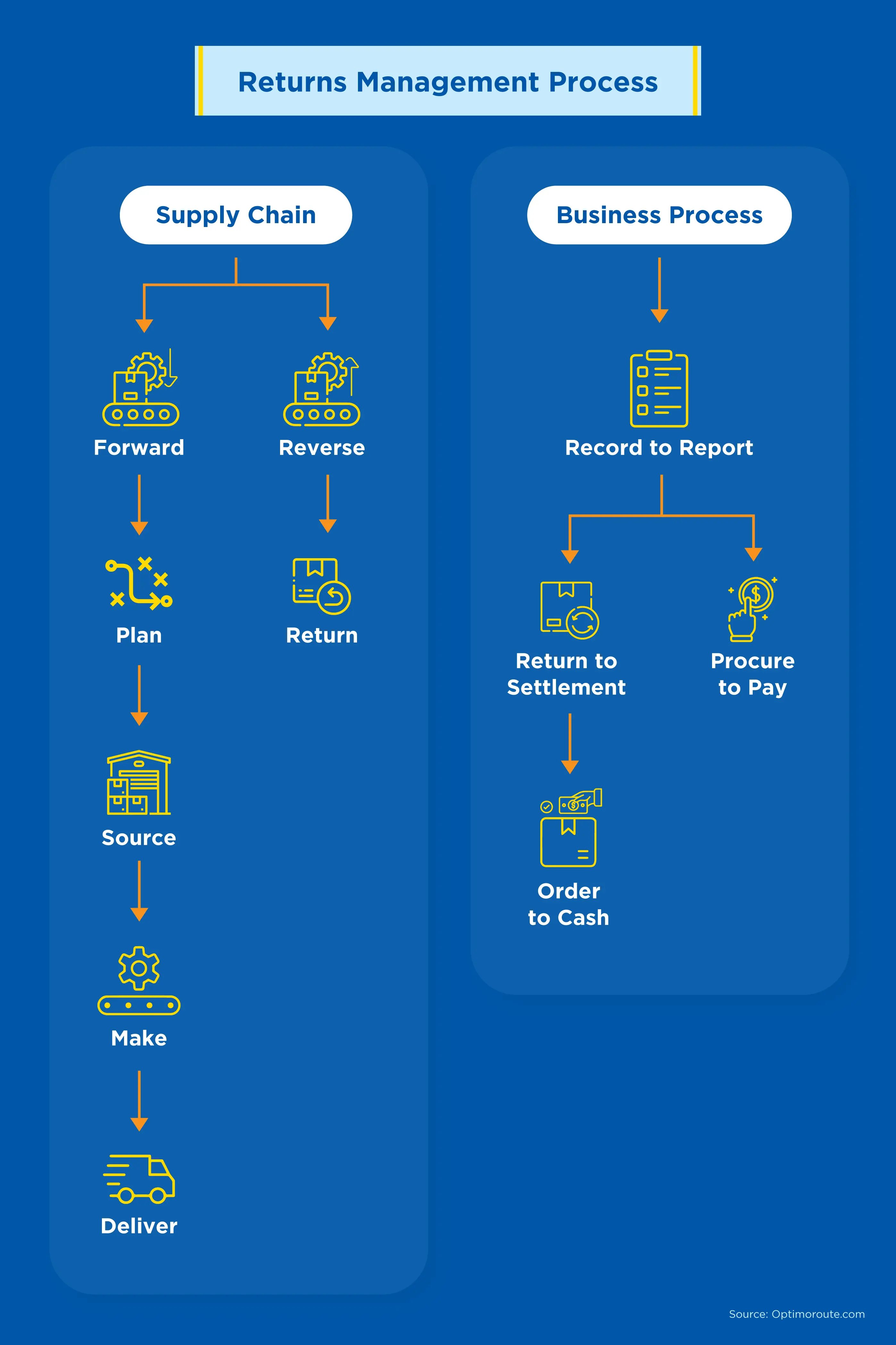
Seamless return management would mean companies can avoid the same issue that led to return. It allows companies to recoup as much production value as possible. Lastly, hassle-free returns can be a brand's differentiator for boosting the brand image and customer loyalty.
Being a time-consuming feat, many companies prefer outsourcing to third-party logistics providers (3PL). 3PLs with expertise in both the forward and reverse supply chain process gives you a competitive advantage.
Return Policy and Procedures (RPP)
The rule or good practice that a company establishes to manage the process by which customers return, or exchange merchandise is its RPP. These policies should be visible and accessible to the buyers. Also, it must be consistently followed by both customers and employees.
Remanufacturing or Refurbishment
Remanufacturing is restoring the functionality or a part of the product. Whereas, refurbishments deals with restoring the product itself without being thorough as remanufacturing. Either way helps companies manage waste and prevent netting out profit on defective items.
Cannibalisation
In reverse logistics, cannibalisation refers to recovering a product part that has reached the end of its service life. For this, products undergo disassembly and rigorous inspection to ensure that the recovered components meet the quality benchmarks for reuse.
Packaging Management
Reverse logistics management with a special focus on packaging aims for efficient, secure, and sustainable packaging processes. It positions businesses to reuse packaging to reduce waste and save packaging costs for returned products.
Unsold Products
Pretty often, a portion of the inventory remains unsold due to poor sales, delivery refusal, or any other reason. That’s when reverse logistics handles its transport. This type of reverse supply chain exclusively deals with transporting unsold items from fulfilment centres or retailers back to manufacturers or distributors.
End of Service Life (EOL)
When the product ceases to meet a customer’s need or does not work, it must be replaced by a better version. Oftentimes, the manufacturer decides to no longer market, support, or sell the product. In such cases, reverse logistics enables the manufacturer to procure and dispose of the products.
Delivery Failure
If a product fails to get delivered, it is sent back to the fulfilment centres, where it is sorted and then shipped back to the manufacturer. If possible, the delivery issue is corrected at this stage, and the returned products are sent for delivery to the customers right away.
Rental Equipment
Rented or leased products must be returned to the company that owns them. Thus, at the end of its lease term, the products are reverse supplied to the company to redeploy or dispose of.
Repair and Maintenance
Companies might need to undertake a reverse logistics process and perform the repair and maintenance work if any issue arises.
“Retailers must rethink returns as a key part of their business strategy,” said Steve Prebble, CEO of Appriss Retail. “Retail is dealing with an influx of returned items. Now is the time to stop thinking of returns as a cost of doing business and begin to view them as a time to truly engage with your consumers.”
What Are the 5 Rs of Reverse Logistics?
The five fundamental components of a reverse logistics process are called the 5 Rs. Each component is crucial to reverse logistics customer satisfaction. They ensure that the returned products continue to generate value and make customers happy.
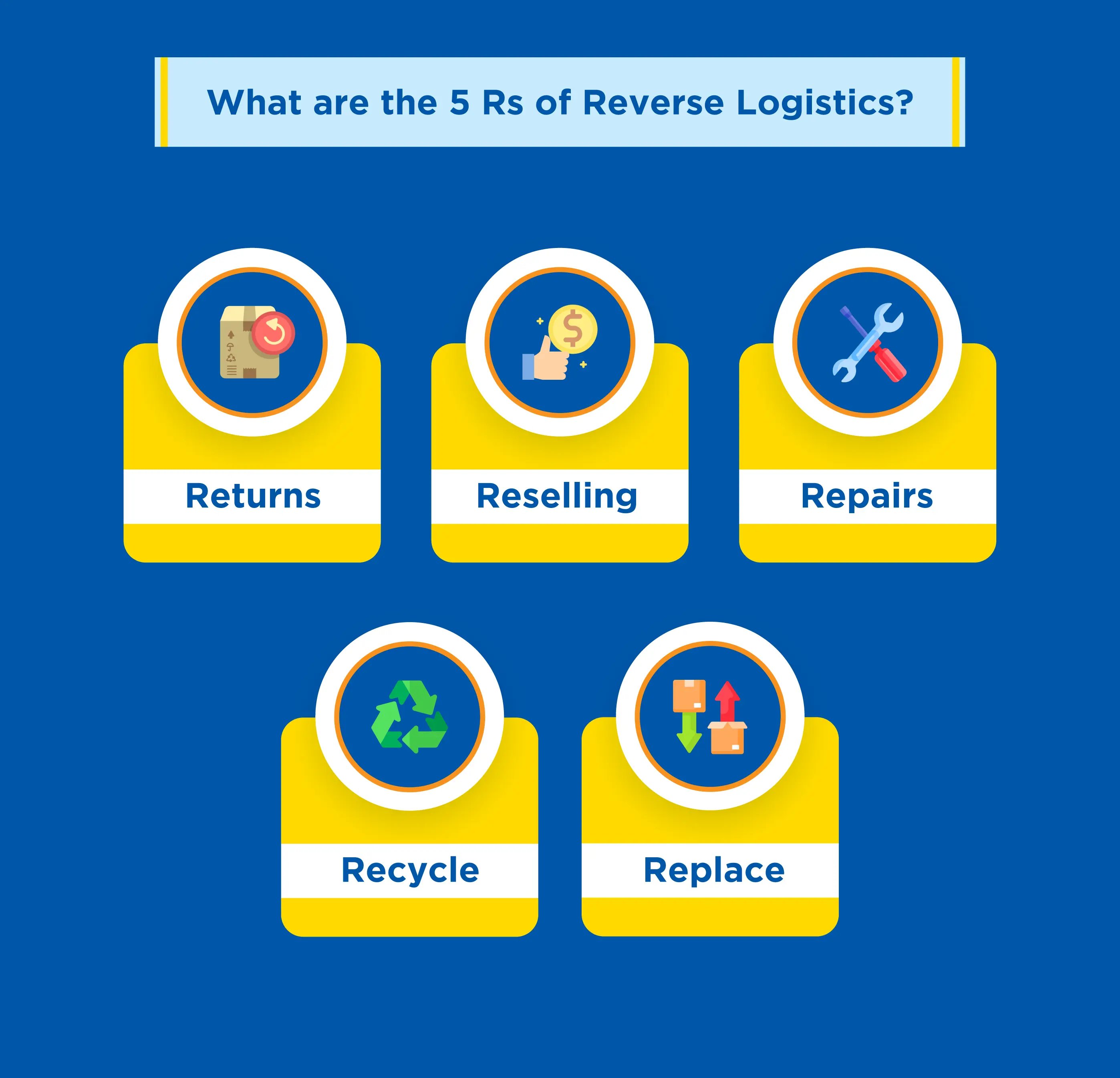
1. Returns
Product return is the first action that triggers the onset of a reverse supply chain. The key to handling returns is to make them pain-free while balancing the cost associated with the merchandise return.
In this context, even though having a concrete return policy pays off, it is equally beneficial to set up processes for receiving, inspecting, and testing products. It helps validate the suitability of a product to be returned to the marketplace.
Nonetheless, the rate of returns is the KPI that a business must keep a sharp eye on. Not only does it impact your bottom line, but it may also reveal inefficiencies in a business.
2. Reselling
Given that 2.27 billion Kgs (5 billion pounds) of waste are generated through returns, reselling is your good chance to turn the return into revenue and reduce waste. If the returned products are in resalable condition, the business can test and repackage them as new or returned products.
3. Repairs
If defects are not too severe, companies recall products back into their production facilities. After the problem is identified, it is repaired and returned to the customers. Or they can also be marked as such and discounted as per the defect. In cases where the product is beyond salvage, it is exchanged for a new one.
4. Recycle
Recycling is a necessity, with conversations around sustainability on a massive uptick. Reverse logistics companies manifest this by returning the end-of-life parts and products to manufacturers. Manufacturers recover and recycle valuable materials to offset the return costs while managing compliant disposal to avoid regulatory penalties.
5. Replace
Some sellers prefer trading a return for replacement instead of repairing it. The delivery personnel handles simultaneous pickup of the return and delivery of its replacement. Companies can even reuse the package the replacement arrives in. This practice helps to shorten the return cycle time, improve the recovery rate of high-value materials, and prevent expenses incurred for packing the old unit.
How Effective Reverse Logistics Can Help Your Business?
It’s easy to think of reverse logistics as shipping of returned orders. But in reality, it is a brand’s linchpin to be a part of a sustainable economy by turning waste into sales. Here’s how:
Strengthens Customer Relationships
A strong reverse logistics in the supply chain brings positive customer feedback. So, even if the customer is returning the product, it’s a golden chance for the business to set itself apart by promising to extend exceptional support beyond the product purchase.
Elevates Brand Image
Customers find it more convenient to do business with brands that offer no-hassle return advantages. They tend to patronise companies that make it easier for them to make sustainable choices. Reverse logistics is a way forward for companies who want to achieve this and dramatically improve their brand image.
Increases Product Utility
Reverse logistics can extend the product life-cycle by increasing its utility and saving it from landfills. It supports companies in discovering new uses for disposed products with a newfound focus on recovery, repair, and recycling.
Reduces Business Risk
Dealing with the return is as important as making a sale, as it can directly affect the customer’s experience with your brand. Despite the defective product, you can appease them by handling the return efficiently, thereby mitigating the risk of costly lawsuits.
Improves Profit Margins
Returned goods can be swiftly transported, inspected, and reworked to be part of the inventory again. In doing so, an optimised reverse supply chain regains value from products that would have been a complete loss if disposed of as such.
What are the Challenges of Reverse Logistics?
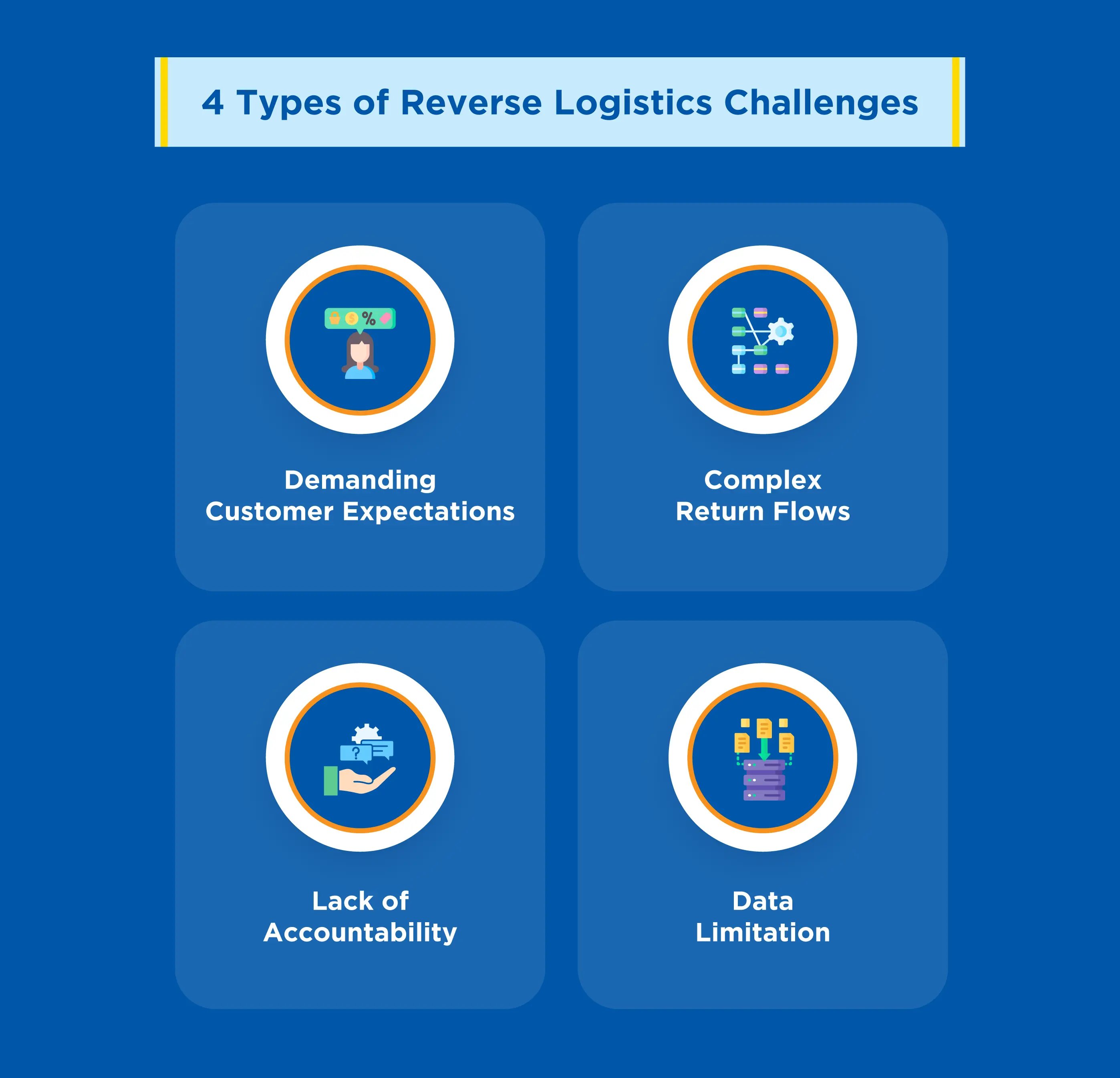
Some of the biggest challenges of reverse logistics need to be overcome to get the most out of it. Here they are:
Demanding Customer Expectations
A study by Emplifi found that around 80% of respondents would leave a brand after three or fewer instances of poor customer experience. Naturally, there is little room for error. Anything that creates negative return experiences — a difficult return process or returns shipping charges — is likely to deter customers from shopping with that brand again.
The truth is that for customers, it's all about convenience. Many of the return features they have strict expectations about originated for online sellers. Yet, the increasing trend is that manufacturers are also measured up against the same standard of customer service. Often the most valuable customers also have the highest rate of returns.
Hence, despite the positive sales impact of easy return policies, managing customers’ towering return expectations becomes an uphill battle for companies.
Complex Return Flows
Moving backward along the supply chain is more difficult than forward logistics. It's because of the multiple business partners and points of origin involved in handling the returns. It makes it challenging for brands to track the information between different parts of the supply chain.
Complicating this further, retailers have little control over the timing and volumes of returns. Because of this, the time it takes to process one return is two to three times the time to fulfil one order.
Lack of Accountability
An efficient return relies on cross-functional coordination among multiple teams, including operations, warehouse, marketing, merchandising, finance, etc. This very aspect restricts organisation's ability to establish the relevant point of accountability, preventing efficient return management.
Data Limitation
It is crucial to amass data throughout the reverse logistics process. But shockingly, only a few organisations understand the full economics of return, including the data about types and causes of products returned. Without the data, it is impossible to address the root cause of the returns. Limited visibility also leads to decisions about repair, recycling, and disposal being made incoherently.
Top 10 Ways to Optimise Your Reverse Logistics Process
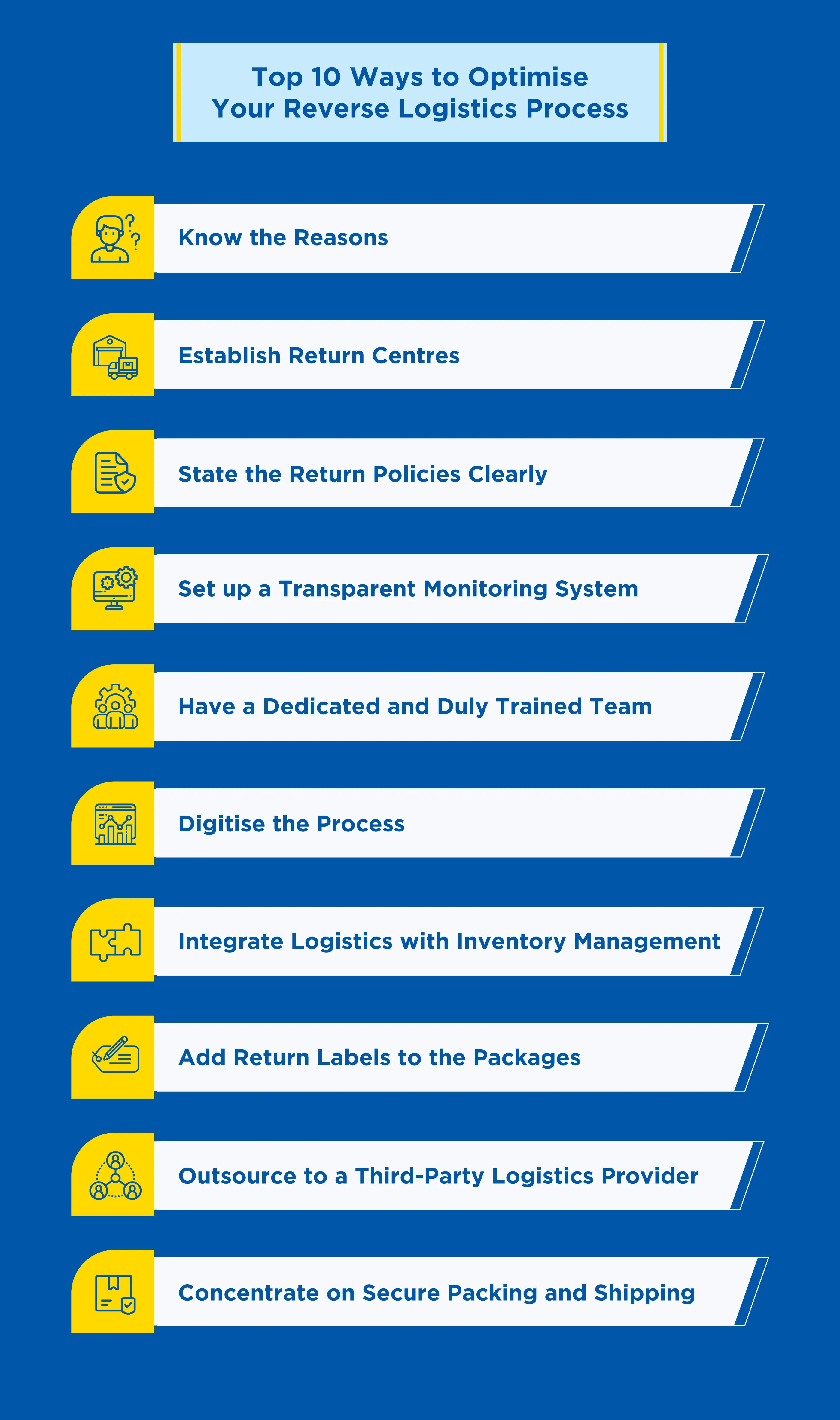
So how to improve the reverse logistics? Each business will have different business goals and return rates. But here are a few common strategies to help you optimise your reverse logistics process.
1. Know the Reasons
Businesses must focus on understanding the root cause of return. Knowing what’s driving them to return the product continually, you can evaluate if the current return policy has any role in encouraging costly returns. Or perhaps you might also see product descriptions or imagery that need any improvement. Or there is a good chance the usage instructions need to be clearer. Gathering the reasons for return will help you find the issues with the product and improve future inventory.
For example, if a particular product is consistently high on returns with complaints about the size, you may want to convey the sizing issue to the manufacturer.
2. Establish Return Centres
We suggest creating a centralised return centre for processing the returned items. A designated space in your warehouse and distribution centres will ensure that the returned goods are handled, inspected, and sorted quickly.
3. State the Return Policies Clearly
A return policy states the criteria for accepting returns and is crucial for making returns easier for you and the customers. With an easy-to-follow rerun policy, you let your potential buyers know what to expect. So they are most likely to understand the process and return the goods faster. It not only improves customer satisfaction but also reduces the strain on your customer service team.
4. Set up a Transparent Monitoring System
The monitoring system can be a great way to enhance the transparency of the reverse supply chain. Using this, businesses can pinpoint the area of the process that needs improvement and control the overall quality of the products.
5. Have a Dedicated and Duly Trained Team
To make your reverse logistics effective, you’ll need a specialised team skilled at evaluating the returned goods. By quickly identifying, sorting, repackaging, and disposing of the returned goods, they can significantly impact the financial KPIs of your reverse supply chain.
6. Digitise the Process
Requesting returns, receiving printable barcodes, or scheduling a return are some of the steps in reverse logistics processes that organisations can easily digitise and automate. It enables them to reduce the massive spending on support centres dramatically. Moreover, investing in technology such as RFID scanners, Warehouse management software can also help you speed things up.
7. Integrate Logistics with Inventory Management
Let your forward logistics, reverse logistics, transportation, and inventory management systems be in sync. This way, your inventory will be visible across the supply chain the moment it is scanned at the sorting centre.
8. Add Return Labels to the Packages
Including a return label in outbound packages is most convenient for your customers if they wish to return the item. It displays all the information required to send the shipment back to the seller such that it can be tracked throughout the reverse journey. It ensures the product's safe return, improving the entire process's efficiency.
9. Outsource to a Third-Party Logistics Provider
Although it is possible to manage returns internally, outsourcing it to a reliable 3PL with reverse logistics as their core always pays off.
With too many moving parts, a reverse supply chain can feel extremely daunting to manage in-house, especially when you have a huge influx of returned goods or if you lack the budget for a dedicated reverse logistics team and technology. Their expertise can help you maximise ROI and establish an efficient return process.
10. Concentrate on Secure Packing and Shipping
While product damage can occur at any time in the supply chain, poor packaging and shipping can substantially boost the chances of damaged goods, so much so that even leaving them unsellable.
Partnering with a reliable freight forwarding and packaging solution provider is the key to minimising the chances of goods being damaged during transit- and, therefore, being returned.
What Are the Advantages of Partnering with a Logistic Provider?
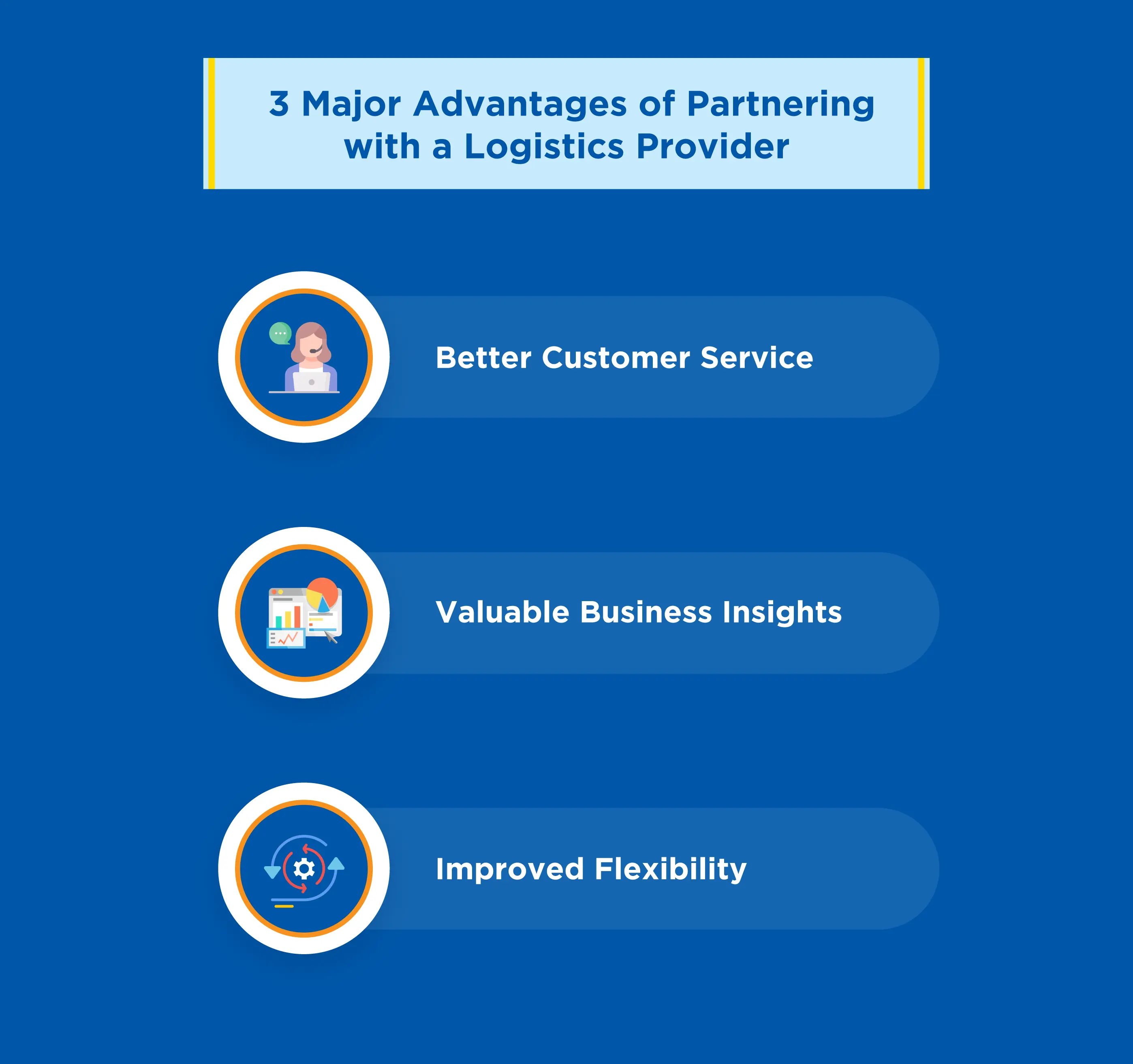
Better customer service
Timely pick-up and delivery of the returned goods from buyers to manufacturers facilitate a better customer experience.
Valuable business insights
A brand can gain the best insights on relevant KPIs around streamlining its operations of the reverse logistics process.
Improved flexibility
They manage inventory for you within their own warehouse and reorder when necessary. Thus, product stocking becomes exceptionally flexible, especially for small businesses with limited space.
Profitability and Product Returns Need Not Be Mutually Exclusive
It’s time that companies stop viewing returns as an inevitable loss. Instead, thinking about reverse logistics as a competitive opportunity will help them optimise and improve their capabilities to handle returns. Not only can it boost revenues, but it can also reduce the environmental toll of reverse logistics.
If you are looking for experts who can offload your team’s burden of implementing and managing hassle-free reverse logistics processes, you’ve come to the right place. Request a consultation with PACK & SEND to learn more about our logistics solutions.
Frequently Asked Questions (FAQs)
What is reverse logistics?
Reverse logistics is a type of supply chain management that moves products from end users back to the seller or manufacturer.
When is reverse logistics used?
In addition to product returns from eCommerce and retail, reverse logistics is used to move goods that are refurbished, repaired, recycled, or disposed of permanently to recapture value.
What are the components of reverse logistics?
The main components of reverse logistics are-
- Returns management
- Return policy and procedure
- Remanufacturing
- Refurbishment
- Cannibalisation
- Packaging management
- Unsold products
- End of service life
- Delivery failure
- Rental equipment
- Repair and maintenance
What is the difference between reverse logistics and forward logistics?
Forward logistics deals with product development, manufacturing, distribution, and fulfilment to the end users. Reverse logistics, on the other hand, is all about the operations related to moving goods from end users to recapture the value from products.
How does reverse logistics can help create value?
A robust reverse logistics strategy-
- Reduces transportation costs
- Improves customer satisfaction
- Generates a better bottom line
- Maintain an efficient flow of goods, and
- Turn waste into sales.
How does reverse logistics contribute to sustainability?
It empowers organisations to resell, reuse or recycle products that would otherwise end up in landfills. It extends the product life cycle and reduces carbon footprint significantly.
